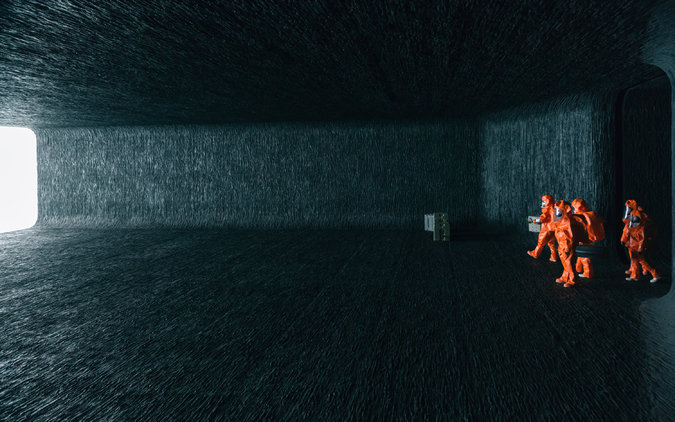
A Hopeful and Fascinating Close to 2016
A new ‘first contact’ film titled “Arrival” premiered this fall. Directed by Denis Villeneuve (“Sicaro,” “Prisoners,” and “Incendies”) and based on an award-winning short story by Ted Chiang, it focuses on linguist Louise Banks (Amy Adams) whose task is to overcome the language gap with the aliens. The timing of the film’s release could not have been more apt. As 2016 wore on, it felt like politics was being increasingly driven by a reptilian-brained fear of outsiders, with Britain leaving the EU, tensions rising in many refugee-accepting countries, and a US presidential campaign won partly on the promise of wall-building. This xenophobia dictates the military’s approach to the aliens in Arrival, a common trope of the genre. What makes Arrival a hopeful and fascinating film to end off the year is its close study of Louise’s courage and creativity in spite of what we know is a shared human impulse: to fear the Other.
Louise is shown giving a linguistics lecture but something is amiss. Her students are distracted and they tell her to turn on the TV. Through the footage, dominating every channel, we see the black oval-shaped spacecrafts hovering silently above the ground. We learn they appeared simultaneously in twelve different countries. It’s a setup similar to “Independence Day”, but these ships feel less threatening, their appearance more melancholic than megalomaniacal. A more appropriate analogy is to the monolith in Stanley Kubrick’s “2001: A Space Odyssey,” an enigmatic alien object that influences and spurs on the course of humanity’s development. While a hysterical media searches for an explanation, the militaries of the respective countries have taken swift control, cordoning off the sites and restricting who can enter and exit. Shortly after, Louise is recruited by Colonel Weber (Forest Whitaker) to help the US government decipher the aliens’ intentions and she is joined by physicist Ian Donnelly (Jeremy Renner).
We first meet the aliens when Louise and Ian, along with their military handlers, enter one of the oval spacecrafts in hazmat suits. Squid-like and given the name “Heptapods” for their seven legs, the aliens seem keen to communicate but remain in a misty area behind an invisible barrier. Louise’s predecessor was fired for not achieving results quickly enough. The pressure is on Louise to establish linguistic common ground and discover the purpose of the Heptapods’ arrival before the military takes aggressive, pre-emptive actions. In an early visit, Louise removes her hazmat suit and walks right up to the invisible barrier, invoking disbelief and admonishment form her military overseers. Her bravery is rewarded, as she is able to connect more intimately with her extraterrestrial interlocutors, setting in motion later breakthroughs. The visuals and thematic content of the scene (depicted in this review’s accompanying image) feel like a nod to Pinocchio and the biblical Jonah, who both end up in the belly of a whale as part of their hero’s journey. In those stories, as in this one, the protagonist must be symbolically swallowed whole into the unknown. As their former selves die, they able to emerge reborn and in possession of new crucial knowledge from the ‘other side’ (see Joseph Campbell).
The most interesting conceptual territory of Arrival is its clever sci-fi extrapolations from linguistic theory. The Sapir-Whorf hypothesis, specifically name-checked in the film, states that the structure of a language determines or greatly influences the modes of thought and behaviour of its speakers. Without going into too much detail, Louise discovers that the Heptapods have a circular structure to their written language, rather than a linear one. The point of imaginative departure is that this linguistic circularity greatly informs and mediates the Heptapods understanding of–and relationship to–time. As Louise gains deeper insight into the Heptapod language, her perspective is increasingly shaped by Heptapod thoughts. Inventively, the largely linear narrative thus far begins taking a more elliptical shape. Louise’s mind frequently flashes in and out of events of ambiguous temporality, what could be day-dreams, memories, or perhaps even oracular foresight. While hazy at times on execution, the film deserves credit for introduction of genuine cognitive estrangement: an idea that compels us to see the world differently (See Darko Suvin).
In the aftershock of 2016, Arrival is a consoling meditation on bridging impossible divides and transcending boxes and biases that govern our thinking. In some ‘first contact’ films, the aliens have a deadly agenda but in Arrival they have a gift to share. That this gift is initially perceived as a threat speaks to all-too-recognizable human tendencies. Louise’s military overseers want to manage risk, and she breaks with protocol in a number of ways that could potentially bring hazardous consequences. By so doing, she shows how we make ourselves vulnerable when we try hardest to achieve mutual understanding. At the same time, she enables herself to gain crucial knowledge for her hero’s journey. As we enter a new year in a political climate that seems as polarized as ever, Arrival is a timely reminder of the virtues, at times necessities, of leaping with abandon into chasms of misunderstanding.
